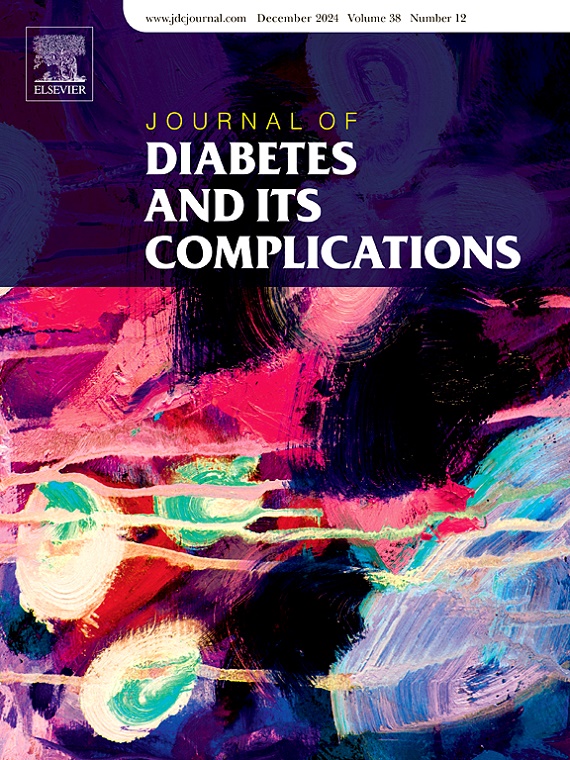Role of rs490683 variant in the promoter region of the ghrelin receptor gene on body weight and metabolic syndrome after a partial meal replacement hypocaloric diet
IF 3.1
3区 医学
Q3 ENDOCRINOLOGY & METABOLISM
引用次数: 0
Abstract
Background and aims
Few studies have evaluated the effect of rs490683 on weight loss. The objective of our study was to evaluate the role of this variant of GHSR gene on body weight loss and cardiovascular risk factors secondary to a partial meal replacement (pMR) hypocaloric diet.
Methods
96 individuals with a body mass index (BMI > 35 kg/m2) were enrolled. Participants consumed a normocaloric, hyperproteic formula twice daily (12-w). Measurements were taken for body weight, BMI, fat mass, waist circumference, blood pressure, lipid profile, fasting insulin levels and HOMA-IR.
Results
The genotype was 70 patients (72.9 %) CC genotype, 19 patients(19.8 %) CG genotype, and 7 patients(7.3 %) GG genotype. The intake of calories, grams of carbohydrates, fats and proteins was higher at 12w in patients carrying the G allele. BMI (−3.5 ± 0.4 kg/m2 vs −1.0 ± 0.2 kg/m2 (p = 0.01)), body weight (−8.5 ± 1.0 kg vs −2.6 ± 1.1 kg (p = 0.01)), fat mass (−7.7 ± 0.3 kg vs −2.6 ± 0.2 kg (p = 0.01)), waist circumference (−7.2 ± 0.3 cm vs −2.9 ± 0.1 cm (p = 0.01)), glucose levels (−12.1 ± 1.4 mg/dl vs −3.1 ± 1.8 mg/dl, p = 0.01), insulin (−10.8 ± 1.2 UI/L vs −3.9 ± 1.1 UI/L, p = 0.01), HOMA-IR (−2.1 ± 1.0 units vs −0.58 ± 0.2 units, p = 0.01), CRP (−1.2 ± 0.1 mg/dl vs −0.7 ± 0.2 mg/dl, p = 0.01), triglycerides (−22.1 ± 4.1 mg/dl vs −5.1 ± 3.2 mg/dl, p = 0.01), total-cholesterol (−22.2 ± 1.3 mg/dl vs −8.8 ± 1.9 mg/dl, p = 0.01), LDL-cholesterol (−15.2 ± 1.1 mg/dl vs −4.7 ± 1.2 mg/dl, p = 0.01), and HDL-cholesterol (6.2 ± 0.4 mg/dl vs −2.9 ± 1.2 mg/dl, p = 0.01) modifications were better in non-G allele carriers. After intervention, the odds ratio (OR) of MS in non-carrier of G allele improved OR 0.48 (95%CI: 0.31–0.73; p = 0.02).
Conclusions
G allele of rs490683 have a deleterious effect on dietary restrictions, body weight and metabolic response after a pMR diet.
胃饥饿素受体基因启动子区域rs490683变异在部分代餐低热量饮食后体重和代谢综合征中的作用
背景与目的很少有研究评估rs490683对减肥的影响。本研究的目的是评估GHSR基因的这种变异在部分代餐(pMR)低热量饮食后体重减轻和心血管危险因素中的作用。方法96例体重指数(BMI >;35 kg/m2)。参与者每天食用两次(12 w)等热量高蛋白配方。测量了体重、BMI、脂肪量、腰围、血压、血脂、空腹胰岛素水平和HOMA-IR。结果CC基因型70例(72.9%),CG基因型19例(19.8%),GG基因型7例(7.3%)。携带G等位基因的患者在12w时卡路里、碳水化合物、脂肪和蛋白质的摄入量更高。BMI(−3.5±0.4 kg / m2 vs−1.0±0.2 kg / m2) (p = 0.01),体重(vs−−8.5±1.0公斤2.6±1.1公斤(p = 0.01)),脂肪量(vs−−7.7±0.3公斤2.6±0.2公斤(p = 0.01)),腰围(−7.2±0.3厘米vs−2.9±0.1厘米(p = 0.01),血糖水平(−12.1±1.4 mg / dl vs−3.1±1.8 mg / dl, p = 0.01),胰岛素(−10.8±1.2 UI / L vs−3.9±1.1 UI / L, p = 0.01), HOMA-IR(−2.1±1.0单位vs−0.58±0.2单位,p = 0.01), c反应蛋白(−1.2±0.1 mg / dl vs−0.7±0.2 mg / dl, p = 0.01),甘油三酸酯(−22.1±4.1 mg / dl vs−5.1±3.2 mg / dl, p = 0.01),总胆固醇(−22.2±1.3 mg / dl vs−8.8±1.9 mg / dl, p = 0.01),低密度脂蛋白胆固醇(−15.2±1.1 mg / dl vs−4.7±1.2 mg / dl, p = 0.01),和脂蛋白胆固醇(6.2±0.4 mg / dl vs−2.9±1.2 mg / dl, p = 0.01)修改好non-G等位基因携带者。干预后,非G等位基因携带者MS的优势比(OR)改善OR 0.48 (95%CI: 0.31-0.73;p = 0.02)。结论rs490683等位基因对pMR饮食后的饮食限制、体重和代谢反应有不利影响。
本文章由计算机程序翻译,如有差异,请以英文原文为准。
求助全文
约1分钟内获得全文
求助全文
来源期刊

Journal of diabetes and its complications
医学-内分泌学与代谢
CiteScore
5.90
自引率
3.30%
发文量
153
审稿时长
16 days
期刊介绍:
Journal of Diabetes and Its Complications (JDC) is a journal for health care practitioners and researchers, that publishes original research about the pathogenesis, diagnosis and management of diabetes mellitus and its complications. JDC also publishes articles on physiological and molecular aspects of glucose homeostasis.
The primary purpose of JDC is to act as a source of information usable by diabetes practitioners and researchers to increase their knowledge about mechanisms of diabetes and complications development, and promote better management of people with diabetes who are at risk for those complications.
Manuscripts submitted to JDC can report any aspect of basic, translational or clinical research as well as epidemiology. Topics can range broadly from early prediabetes to late-stage complicated diabetes. Topics relevant to basic/translational reports include pancreatic islet dysfunction and insulin resistance, altered adipose tissue function in diabetes, altered neuronal control of glucose homeostasis and mechanisms of drug action. Topics relevant to diabetic complications include diabetic retinopathy, neuropathy and nephropathy; peripheral vascular disease and coronary heart disease; gastrointestinal disorders, renal failure and impotence; and hypertension and hyperlipidemia.
 求助内容:
求助内容: 应助结果提醒方式:
应助结果提醒方式:


